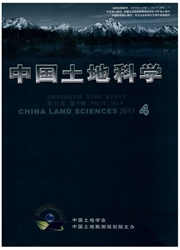

 中文摘要:
中文摘要:
土地利用多功能性是根据社会经济目标进行土地利用的过程,是确保社会经济与生态环境协调发展的关键。本文通过构建"社会—经济—生态"三维土地利用多功能性评价指标体系,对1990-2013年东北地区土地利用多功能性进行综合评价,旨在阐释其土地利用多功能性演化的时空格局。研究表明:1990-2013年东北地区土地利用功能值均呈现上升态势但增速有所差异,黑龙江、吉林、辽宁土地利用功能发展程度依次递增,其年均增长率分别为2.976%、2.725%、2.261%;黑龙江和吉林社会功能值呈现波动性增长,辽宁则表现为阶段性变化;黑龙江经济系统功能值逐渐增大,而吉林和辽宁经济功能值总体呈现上升趋势,但在2000-2005年有所波动;黑龙江与吉林生态系统功能值呈现由基本稳定转变为波动增长的趋势,而辽宁则始终具有较大波动性;经济功能中的土地的生产功能与交通功能对东北地区省域土地利用功能均有较大影响,经济和社会因素对黑龙江与吉林土地利用功能多样性影响较大,生态因素则对其影响较小,而经济、社会和生态因素对辽宁土地利用功能均有较大影响。
 英文摘要:
英文摘要:
Multi- functionality of land use is the result of the process of land utilization according to the socioeconomic goals, which is the key to ensuring the coordinated development of the socioeconomic and ecological environments. By constructing a social- economic- ecological multi- functional land use evaluation indicator system, this article comprehensively examines the multi-functionality of land use from 1990 to 2013 in Northeast China, which aims to explain the spatiotemporal patterns of multi-functionality of land use in the area.The results show that functional values of land use showed an upward trend during 1990- 2013 in Northeast China, but the growth rates differed. The development levels of land use functions in Heilongjiang, Jilin, and Liaoning Provinces were in an ascending order, and the average annual growth rates were 2.976%, 2.725%, and2.261%, respectively. The social function values of Heilongjiang and Jilin Provinces increased with some fluctuations, but Liaoning Province showed a periodical change. The economic function values of Heilongjiang Province increased, but that of Jilin and Liaoning Provinces showed an overall upward trend yet fluctuated in2000 to 2005. The ecological function values of Heilongjiang and Jilin Provinces were stable at the beginning of the period then showed an increasing trend with some fluctuations, whereas in Liaoning Province it always showed greater volatility. Land production and transportation, which are important parts of the economic function, had a great impact on the land use functionality of the three provinces in Northeast China. Economic and social factors had a greater impact on the multi-functionality of land use in Heilongjiang and Jilin Provinces,while ecological factors played a smaller role. But in Liaoning Province, economic, social, and ecological factors all had important impacts on the multi-functionality of land use.
 同期刊论文项目
同期刊论文项目
 同项目期刊论文
同项目期刊论文
 期刊信息
期刊信息
